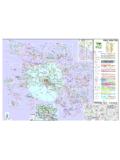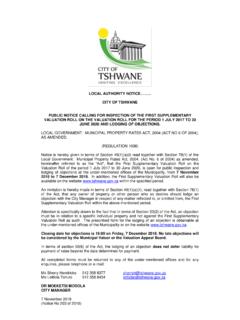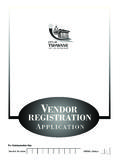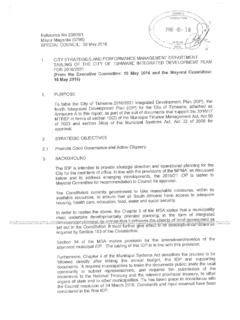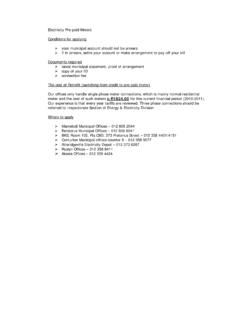Transcription of CTMM POLICY ON THE CONTROL OF CHEMICAL SUBSTANCES
1 CTMM POLICY ON THE CONTROL OF CHEMICAL SUBSTANCES . A. POLICY . To provide a safe and healthy workplace for all CTMM employees. To avoid environmental damage. 1. SCOPE. All CTMM departments where hazardous or potentially Hazardous CHEMICAL SUBSTANCES (HCS). are used, stored, transported or disposed. 2. OBJECTIVES. To ensure that hazardous or potentially hazardous SUBSTANCES are managed according to the CTMM POLICY and legal requirements;. To avoid the potential liabilities and damage to health & safety from irresponsible management of hazardous SUBSTANCES . To avoid possible environmental pollution due to the accidental spillage or release of HCS. 3. REFERENCES. SABS Code 0228: The Identification and Classification of Dangerous SUBSTANCES and Goods.
2 SABS Code 0229: Packaging of Dangerous Goods for Road and Rail Transportation in South Africa. SABS Code 0263: The Warehousing of Dangerous Goods - Enclosed Storage Areas and Covered and uncovered Outdoor Storage Yards. Hazardous CHEMICAL SUBSTANCES Act (Act 15 of 1973). Occupational Health and Safety Act (Act 85 of 1993). General Machinery Regulation 8, promulgated under the Occupational Health and Safety Act (Act 85 of 1993). General Machinery Regulation , promulgated under the Occupational Health and Safety Act (Act 85 of 1993). General Safety Regulation 4(10), promulgated under the Occupational Health and Safety Act (Act 85 of 1993). National Building Regulations Act (Act 103 of 1977).
3 Mine Health and Safety Act, 29 of 1996, Regulation 2010/01/20. SABS Code 072: The Safe Handling of Pesticides 0400 Part O: The application of the National Building Regulations The National Environmental Management Act, 1998 (Act 107 of 1998). 4. DOCUMENTATION. Material Safety Data Sheets Departmental CHEMICAL Inventory (AnnexureA). List of Notifiable SUBSTANCES (Annexure B). 5. DEFINITIONS. UNO No.: United Nations Organisation CHEMICAL Identification Code Number. Group I Hazardous CHEMICAL SUBSTANCES : Poisonous (toxic) SUBSTANCES , as specified in Appendices E and F of SABS Code 0228: The Identification and Classification of Dangerous SUBSTANCES and Goods. Group II Hazardous CHEMICAL SUBSTANCES : All SUBSTANCES and goods specified in the SABS Code 0228: The Identification and Classification of Dangerous SUBSTANCES and Goods, with the exception of Class 1 (Explosives) and Class 7 (Radioactive SUBSTANCES ).
4 Group III Hazardous CHEMICAL SUBSTANCES : Electronic products as declared so in terms of R1302, 14 June 1991. Group IV Hazardous CHEMICAL SUBSTANCES : Radio-active materials, as defined in the Nuclear Energy Act, 1993. Health & Safety Representative: A departmental representative elected in terms of section 17 or appointed in terms of section 19 in the Occupational Health & Safety Act, 85 of 1993. Hazardous CHEMICAL SUBSTANCES (HCS): Any toxic, harmful, corrosive, irritant or asphyxiant substance , or mixture of such substance . CHEMICAL SUBSTANCES which have been declared as Group I,II,III or IV hazardous SUBSTANCES in terms of the Hazardous SUBSTANCES Act (Act 15 of 1973).
5 Material Safety Data Sheets (MSDS): A document, issued in terms of the Occupational Health and Safety Act (Act 85 of 1993), which lists information about the handling, storage, transportation and emergency measures relevant to a dangerous CHEMICAL . Occupational Safety Officer: A person employed in the Occupational Heath & Safety Section of the CTMM, sub-section Occupational Safety. 6. RESPONSIBILITY. Prime: Head of Division Secondary: Head of Occupational Health and Hygiene Head of Occupational Safety 2010/01/20. Head of Procurement Head of Environmental Management Systems The execution of this POLICY is the responsibility of the Head of the Division which is in line with his obligations to provide and maintain a safe and healthy work environment as per the CTMM.
6 Health & Safety POLICY . The Head of Occupational Health and Hygiene shall provide an advisory service in line with this POLICY which may in some instances include the rendering of Occupational Hygiene measurements. Any costs incurred through the appointment of external consultants or analysis fees on samples taken will be for the specific department. The Head of Division may appoint a CHEMICAL substance Co-ordinator in writing to assist in the execution of this POLICY . The Head of Environmental Resource Management shall provide an environmental advisory service in line with this POLICY . Any delegations made in respect of this POLICY by the Head of the Division to subordinates must be done in writing.
7 7. EXECUTION. Identification and CONTROL of Hazardous CHEMICAL SUBSTANCES The Head of the Division shall be responsible for developing and maintaining an inventory of all chemicals in his / her area of responsibility. To assist the Head of Division in the execution of this POLICY , he / she may appoint a Hazardous SUBSTANCES Co-ordinator. The inventory shall indicate which chemicals shall be considered hazardous, based on the definitions in Section 5 above. The Head of the Division shall, in collaboration with the Departmental Hazardous substance Co-ordinator for the relevant areas, compile a Departmental CHEMICAL Inventory (Annexure A). This inventory shall be made available to the Procurement Manager who will distribute it to his staff.
8 No chemicals that do not appear on this list may be purchased without prior reference to the Departmental Hazardous substance Co- ordinator for approval and inclusion on the inventory. The Head of a Division who has any substance set out in Annexure B (List of Notifiable SUBSTANCES ) or any mixture thereof, in a quantity which at any time is equal to or in excess of the quantity specified opposite that substance on his premises in a single fixed storage vessels, must notify the divisional inspector, Department of Labour, thereof. The Departmental Hazardous substance Co-ordinator shall be the only person/s authorized to update the inventory and will issue the Procurement Manager with the latest update.
9 The legal requirement regarding the obtainment of MSDS's shall be stipulated (and included in the general conditions for people who would want to register as providers) by the procurement manager to all potential suppliers to the CTMM. 2010/01/20. No HCS shall be allowed on site without an accompanying Material Safety Data Sheet, unless the relevant MSDS's is already available on site. The area health & safety representative or any other appointed person shall endeavour to obtain MSDS's for non-hazardous chemicals as well, although this shall not be compulsory. MSDS shall be kept on site by the Departmental Hazardous substance Co- ordinator and shall be available to occupational health clinics and accessible to all employees who may work with or could possibly come into contact with the relevant HCS's or potentially hazardous chemicals.
10 Information relevant to health, safety and environmental hazards indicated in the MSDS shall be communicated (by the employee's supervisor) to those using the HCS in an effective manner (refer to POLICY on HCS). Storage of Hazardous SUBSTANCES CONTROL of temporary storage of HCS and potentially hazardous chemicals shall be the responsibility of the Departmental Hazardous CHEMICAL substance Co ordinator unless otherwise indicated in a departmental operating procedure. Provisions indicated in the SABS Code 0263 shall be adhered to where quantities meet or exceed those indicated in Annex A of the Code. Where quantities are less than these levels, the provisions of the Code shall be followed as guidelines.
